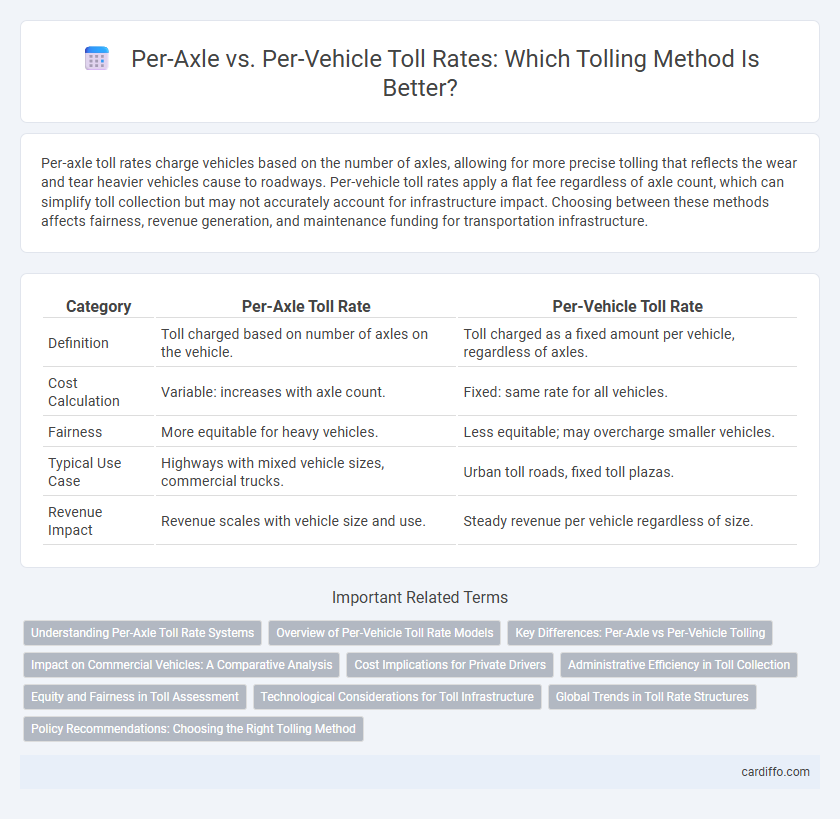Per-axle toll rates charge vehicles based on the number of axles, allowing for more precise tolling that reflects the wear and tear heavier vehicles cause to roadways. Per-vehicle toll rates apply a flat fee regardless of axle count, which can simplify toll collection but may not accurately account for infrastructure impact. Choosing between these methods affects fairness, revenue generation, and maintenance funding for transportation infrastructure.
Table of Comparison
| Category | Per-Axle Toll Rate | Per-Vehicle Toll Rate |
|---|---|---|
| Definition | Toll charged based on number of axles on the vehicle. | Toll charged as a fixed amount per vehicle, regardless of axles. |
| Cost Calculation | Variable: increases with axle count. | Fixed: same rate for all vehicles. |
| Fairness | More equitable for heavy vehicles. | Less equitable; may overcharge smaller vehicles. |
| Typical Use Case | Highways with mixed vehicle sizes, commercial trucks. | Urban toll roads, fixed toll plazas. |
| Revenue Impact | Revenue scales with vehicle size and use. | Steady revenue per vehicle regardless of size. |
Understanding Per-Axle Toll Rate Systems
Per-axle toll rate systems charge vehicles based on the number of axles, reflecting the impact on road wear and infrastructure maintenance costs more accurately than per-vehicle rates. This method incentivizes lighter and smaller vehicles, as fees increase with each additional axle, aligning toll expenses with the actual usage and damage potential. Understanding per-axle toll rates helps transportation planners optimize revenue while promoting fair cost distribution across different vehicle types.
Overview of Per-Vehicle Toll Rate Models
Per-vehicle toll rate models charge a fixed fee based on the entire vehicle rather than individual axles, simplifying toll collection and billing processes. These models often use vehicle classification systems that consider factors like size, weight, and vehicle type to determine toll rates, providing a straightforward approach compared to per-axle systems. Implementing per-vehicle rates can reduce administrative costs and improve traffic flow by minimizing the need for detailed axle counting technologies.
Key Differences: Per-Axle vs Per-Vehicle Tolling
Per-axle toll rates charge vehicles based on the number of axles, directly correlating toll costs with vehicle size and weight, which ensures a fairer distribution of road maintenance expenses. Per-vehicle toll rates apply a flat fee regardless of axle count, simplifying toll collection but potentially disadvantaging larger vehicles that cause more road wear. This key difference affects revenue generation, equity, and infrastructure funding strategies in tolling systems.
Impact on Commercial Vehicles: A Comparative Analysis
Per-axle toll rates create a direct correlation between vehicle weight and toll costs, incentivizing commercial vehicles to optimize load distribution and axle count for cost efficiency. In contrast, per-vehicle toll rates impose a flat fee regardless of axle configuration, often leading to higher expenses for heavily loaded commercial trucks. This comparative analysis highlights how per-axle pricing aligns toll costs with road wear and transport logistics, promoting equitable infrastructure funding and influencing commercial fleet operations.
Cost Implications for Private Drivers
Per-axle toll rates often lead to higher costs for private drivers with vehicles carrying multiple axles, such as trucks or recreational vehicles, compared to a flat per-vehicle toll rate. This pricing structure reflects the wear and tear each axle imposes on road infrastructure, resulting in variable expenses based on vehicle configuration. Private drivers with standard passenger cars benefit from per-vehicle toll rates, which offer predictable and generally lower expenses irrespective of axle count.
Administrative Efficiency in Toll Collection
Per-axle toll rates improve administrative efficiency by enabling precise toll calculations based on actual vehicle weight and axle count, reducing disputes and revenue leakage. This method streamlines toll collection systems through automated classification technologies, minimizing manual interventions. Per-vehicle toll rates, while simpler, often lead to overgeneralization, increasing administrative overhead due to frequent exceptions and adjustments.
Equity and Fairness in Toll Assessment
Per-axle toll rates provide a more equitable and fair assessment by charging vehicles based on their impact on road wear and infrastructure maintenance, reflecting the true cost each vehicle imposes. Per-vehicle toll rates risk overcharging smaller vehicles while undercharging heavier, multi-axle trucks, leading to disproportionate burden distribution. Implementing per-axle pricing ensures fairness in toll collection by aligning fees with vehicle size, weight, and axle count, promoting infrastructure sustainability and reducing inequities.
Technological Considerations for Toll Infrastructure
Per-axle toll rates require advanced sensor technology capable of accurately detecting and classifying the number of axles on each vehicle, such as inductive loops, weigh-in-motion systems, or high-resolution cameras. Per-vehicle toll rates simplify infrastructure demands but may lead to revenue disparities, as large multi-axle vehicles pay the same as smaller ones, necessitating less sophisticated but less precise Toll Collection Systems. Implementing per-axle tolling involves integrating real-time data processing, vehicle classification algorithms, and adaptive tolling platforms to optimize traffic management and revenue collection efficiency.
Global Trends in Toll Rate Structures
Global trends in toll rate structures reveal a shift towards per-axle toll rates to better account for road wear caused by heavy vehicles, promoting fairer cost distribution among users. Per-axle tolling systems, increasingly adopted in Europe and Asia, enable precise charges based on vehicle weight and axle count, improving infrastructure maintenance funding. In contrast, per-vehicle toll rates remain prevalent in regions where administrative simplicity and ease of enforcement are prioritized, despite less sensitivity to actual road damage.
Policy Recommendations: Choosing the Right Tolling Method
Per-axle toll rates provide a fairer and more efficient pricing mechanism by reflecting vehicle weight and road impact, which supports roadway maintenance funding and reduces infrastructure damage. Policymakers should adopt per-axle tolling for heavy trucks to incentivize load distribution while using per-vehicle rates for passenger vehicles to simplify toll collection. Implementing dynamic tolling systems with differentiated rates enhances traffic management and promotes equity across vehicle classes.
Per-Axle Toll Rate vs Per-Vehicle Toll Rate Infographic

 cardiffo.com
cardiffo.com